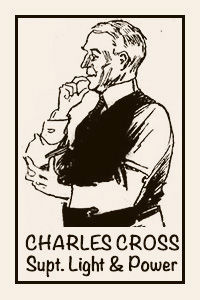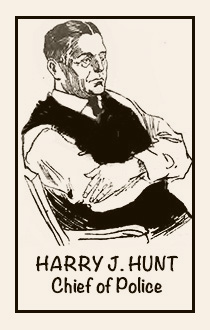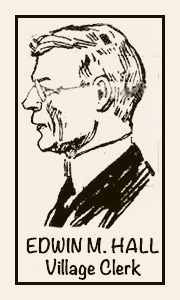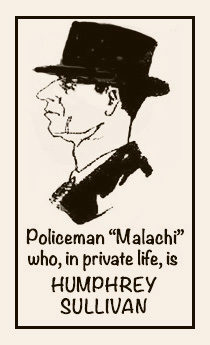Syracuse Herald, Sunday, September 22, 1918
Solvay is impolite. It blows smoke in your face from scores of gigantic cigarets tilted skyward.
Solvay is not impressive from a standpoint of beauty when you enter it. But then Solvay is lopsided. You have to go up the hill or “over the hump” before you see the real beauty of the village.
Solvay is hunch-backed and has bad feet. That is, the feet are not attractive, but they are useful. They’re industrial feet and they hold up Solvay well.
 Solvay also looks at if someone had swept up things from the top of the hill, where it is clean and beautiful, down to the foot and left them there. Solvay also looks at if someone had swept up things from the top of the hill, where it is clean and beautiful, down to the foot and left them there.
But Solvay is one of the best governed villages in the state or country. It is up-to-date and progressive. There isn’t a street that Malachi, the “cop” treads that isn’t macadamized and Malachi treads ‘em all and has treaded ‘em for these ten years.
The village has its own lighting and power plant — or rather it belongs to Charlie Cross, who is superintendent. That is to say, Mr. Cross is the boss of those things in Solvay, and a pretty good boss he is.
Hunt is the First Man You Hear About.
Almost the first man you hear of in Solvay village outside the works is Chief of Police Hunt. If you happen to be an undesirable,, the chief hears of you first and sends Malachi to offer you the  privilege of the unexclusive Hunt clubhouse in the basement of the Village Hall. privilege of the unexclusive Hunt clubhouse in the basement of the Village Hall.
And it’s Bowers for you in the morning. William H. Bowers is police justice and justice of the peace. He holds court every morning and Monday and Thursday nights.
Dr. Kanar Is Many Things.
Dr. W. P. Kanar is president of the village. Dr. Kanar is also many other things. He is health officer of the town of Geddes, examining physician for the Solvay Process Company, and he has a large private practice and no leisure. The doctor finds time every day to visit the Village Hall and confer with the village officers there.
He is president all the time and he is in close touch with all the affairs of the village.
 Edwin M. Hall has been village clerk since 1910 and the village is assured that its records are kept correctly and that Mr. Hall’s work is conducted well. Edwin M. Hall has been village clerk since 1910 and the village is assured that its records are kept correctly and that Mr. Hall’s work is conducted well.
Despite its flat feet, Solvay is doing more than limited military service. Besides the “works,” there are many other factories that are doing war work. The women of the village are active all the time, scores of young men have gone to war and the soldiers from the camp find always a warm welcome at Military Hall. Here the soldier can write letters or have a bath or play pool or other games or read as he likes.
Nearly all the young men of the village have gone to war.
Solvay is unique in the fact that hundreds of people who work there do not live there. They come out in the morning and go back at night. It is first and foremost an industrial village with the big Solvay Process works as the principal industry. Many of the employees live in Syracuse.
It Is Short of Houses.
Solvay has a great shortage of houses. If it had more houses, it could fill them and keep them filled. As it is now, there is a great scramble for street cars at quitting time at the big plants every afternoon. It is impossible to find an available house in Solvay. Only forty percent of Solvay Process employees live in the village.
As it is, more than 6,000 persons make their homes in Solvay. There are about 1,000 residences in the village — at least, there are that many water meters, according to Superintendent Cross. Otisco Lake water is used.
About 650 residences use electric light furnished by the village. The village streets are lighted by 300 incandescent lamps and well lighted. The village furnishes all power to plants except to the Solvay Process Company.
The industries at Solvay include Pass & Seymour, with 500 hands; Frazer & Jones with 400; the Hammond Steel Company with 200, and the Iroquois China Company with 150 employees
Believes in Education.
Mr. Cross has been superintendent of light and water about eight years.
The fire department is headed by Patrick Nolan as chief. There are three hose companies, each one of high grade. If there is a fire, these companies are on the ground before any fire has a decent chance to leave the starting post. They also shine in prize drill and other contests.
Solvay believes in educating its children. Solvay schools have an excellent reputation, but the children are learning more than the school curriculum. They go outside to learn.
Just the other day a whole class of girls visited the Village Hall to find out just how the village affairs were conducted. They interviewed Chief Hunt and Clerk Hall and Superintendent Cross and others. They wanted to know just what each officer did and why, and who was in charge of every department. They were studying municipal affairs, getting their information first hand, not from books.
There are three schools in the village, High, Boyd and Prospect, and every one is an up-to-date school. The community idea is fostered everywhere.
Fifty-four teachers are in service in the Solvay schools, and Roy B. Kelly is superintendent.
Solvay has a library of 18,500 volumes.
Politics at Boiling Point.
The village was incorporated in 1894 with the late Frederick R. Hazard at its first president. It had then a population of 1,762 and it is now more than 6,000.
After its incorporation, the village didn’t job along contented. It began to go after improvements. The water and lighting systems were installed in 1895, the fire department organized the same year and the police department the next year. Then came the sewer system and pavements and other improvements.
Politics in Solvay reach the boiling point at times. There have been some close fights in the village. There was the time Dr. Kanar and Charles Glenn had a tie vote for the office of president of the village.
Solvay isn’t dry, but it’s a deal dryer than it used to be. There’s plenty to go around, but there aren’t so many places to visit as there used to be.
When Harry Hunt became police chief, there were forty-seven saloons. That was about ten years ago. There are now but ten saloons, and they were down to seventeen before the new law went into effect restricting them further.
Solvay people have always been for good government and they have it. Those who live there believe it is one of the best places in the state. Every street is macadamized and every street has a cement sidewalk. Moreover, when a sewer is put in or a sidewalk built, the taxpayer doesn’t have to pay for it directly. All that comes out of the village tax. There is no local assessment.
And the village tax rate is only $12.80.
Solvay is one of the most cosmopolitan villages of its size in the country. There are people of almost every nationality there. They work in the big plants and for the most part are becoming pretty good citizens.
Chief Hunt and six uniformed policemen and two plain clothes men succeed in keeping the village well policed. In fact, the people say that Hunt is one of the best chiefs in the business, if his field is comparatively small.
Solvay Behaves Itself.
He was appointed in 1908 and before that he was for thirteen years a policeman in the village. There has been a big decrease in the number of arrests of late. Where they used to average about 144 a month, they now number ab out 85 a month. So evidently Solvay is behaving itself comparatively well in these wartimes.
 Malachi of the police is one of the best known men in Solvay. His name is Humphrey J. Sullivan, but they called him Malachi when he was a boy, and the name has stuck. Malachi is a hardworking officer and when he goes out to get ‘em, he fetches ‘em, Malachi of the police is one of the best known men in Solvay. His name is Humphrey J. Sullivan, but they called him Malachi when he was a boy, and the name has stuck. Malachi is a hardworking officer and when he goes out to get ‘em, he fetches ‘em,
Lamont Stilwell has been village attorney of Solvay for so many years that most people can’t remember when he wasn’t. He was there when the village was incorporated and he has been counsel in everything for which the village ever needed a counsel.
Not many villages can boast of a better village hall than Solvay. It was built in 1912. Before that, all the village affairs were conducted from the Town Hall. The new building cost $20,000 and it houses every village department. Court is held there, police headquarters are there, Village Clark Hall, Superintendent Cross and Superintendent of Streets Charles H. Green have offices there. The exemption board also has quarters there.
When you get past the pyramid of broken stone in Milton Avenue and up the hill by the Village Hall, you see that Solvay is a place of war gardens. Garden meets garden on a big hillside and hundreds of dollars worth of vegetables were raised there during the summer.
Myron C. Darrow taught the first school in Solvay. That was in 1863 — before there was any Solvay, in fact. When he built a house in Milton Avenue it was the six house and now it bears the number 1703.
Solvay has one big disadvantage. It is long and ungainly. It’s a long way from one end to the other in Solvay, and it’s best to take a streetcar.
Everybody works in Solvay. You can’t get away from work. With the Solvay Process Company barring the way on one side and the other factories making a barrage beyond and Chief Hunt up on the hill, the only way to get out of work in Solvay is to leave town.
And that’s hard work, too, for you have to work your ways into a crowded street car and you hang onto a strap and keep your balance and move up forward till you are almost crushed against the motorman. One of the real thrills in life in Solvay is getting out of there when the “works” whistle blows and 3,500 persons rush for one car and take it they way the Americans took Chateau Thierry. |

 The village of Solvay was the place Central New Yorkers loved to hate. Like comedian Rodney Dangerfield, Solvay got no respect, but it did get a lot of bad press.
The village of Solvay was the place Central New Yorkers loved to hate. Like comedian Rodney Dangerfield, Solvay got no respect, but it did get a lot of bad press. Solvay also looks at if someone had swept up things from the top of the hill, where it is clean and beautiful, down to the foot and left them there.
Solvay also looks at if someone had swept up things from the top of the hill, where it is clean and beautiful, down to the foot and left them there. privilege of the unexclusive Hunt clubhouse in the basement of the Village Hall.
privilege of the unexclusive Hunt clubhouse in the basement of the Village Hall. Edwin M. Hall has been village clerk since 1910 and the village is assured that its records are kept correctly and that Mr. Hall’s work is conducted well.
Edwin M. Hall has been village clerk since 1910 and the village is assured that its records are kept correctly and that Mr. Hall’s work is conducted well. Malachi of the police is one of the best known men in Solvay. His name is
Malachi of the police is one of the best known men in Solvay. His name is